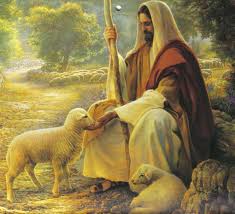EXEGESIS PAPER
ON
LUKE 15: 1-32 PARABLES OF LOST SHEEP, LOST COIN AND LOST SON
BY
DEAN SHINAVER
THIS IS A REQUIREMENT OF AMRIDGE UNIVERSITY OF THE GOSPEL OF LUKE, DR. RODNEY CLOUD TO FULFILL A MASTER DEGREE IN DIVINITY, FALL 2009, OCTORBER 25, 2009
CONTENTS
INTRODUCTION 3
BACKGROUND 4
THE SIGNIFICANT OF THE PARABLE 5
BIBLIOGRAPHY 11
INTRODUCTION
This parable of lost sheep, lost coin and lost son is very unique and meaningful for our
Christian life. The parable of the lost sheep is very applicable to the great work of man's
redemption. This is an example that even though a man who lost a sheep. He left his 99
sheep to look for another one. The lost sheep represents the sinner as departed from God,
and exposed to certain ruin if not brought back to him, yet not desirous to return. God
will not leave one lost sheep and He will look for the lost sheep. Christ is earnest in
bringing sinners home. In the parable of the lost piece of silver, that which is lost is one
piece, of small value compared with the rest. Yet the woman seeks diligently till she finds
it. This represents the various means and methods God makes use of to bring lost souls
home to himself, and the Savior's joy on their return to him. How careful then should we
be that our repentance is unto salvation. The lost son is a represent of a sinner who comes
back to a father and repents his sins. God wants all sinners to come back to Him and
repent. These three parables represent the love of Jesus to all sinners. He loves us so
much.
I. Background A. The surrounding. "This passage is an addition to the first edition of the fourth gospel. It is suggested that the early exclusion from the gospels may be due to its inconsistency with the strict disciplinary treatment of adultery then customary."[1] Luke particularly addressed the needs of the poor and this parable reaffirms that God seeks the social outcasts, the lost. In this chapter starts with the Pharisees and the scribes murmured/grumbled saying, ?"This man receives sinners and eats with them. V.2" This sentence unlocks the meaning of the parable."[2] Jesus portrays two groups of people who were in conflict: the tax collectors/other sinners verses the Pharisees/scribes. We have seen this conflict several times before in the life of Jesus. The Pharisees also grumbled when Jesus ate with Levi, the tax collector (Luke 5:30) and also when Jesus stayed at the home of Zacchaeus, the chief tax collector (Luke 19:7). "In chapter15 where there are three parables on this theme. They illustrate that the goodness and mercy of God is for everyone, especially the most neglected and despised. Luke's parable is triggered by the grumbling of the Jewish religious leaders because Jesus has eaten with outcasts."[3] Crowds came to hear him (Luke 15:1). Jesus let them stay for a short time, and he taught them. But many Pharisees, who were the leaders of the Jewish religion, did not like this (Luke 15:2). They said that a good man should not be with sinners.
B. The theme. Lost and found: this is the theme of Luke 15. A pair of short parables (of the Lost Sheep and Lost Coin) builds up to the Parable of the Prodigal Son. Luke has inherited a form of the Lost Sheep; Matthew knows of it, too. Luke has paired it with the Lost Coin. Once more, he ensures that his stories give equal weight to a man (who has lost the sheep) and a woman (who has lost the coin). C. The key word in Greek "The key word of chapter 15 is "repent". The word translated repent in English New Testaments is the Greek word metanoeo. Repentance involves a change of mind , waking up to reality, seeing things as they really are, and recognizing the error of your ways , resulting in a change of action. Repentance includes forsaking old patterns, habits, priorities, and all things that have controlled you (gods). Repentance means accepting Jesus as Lord. To repent is to forsake all other gods and embrace Jesus Christ as your Lord and God."[4]
II. The significant of the parable A. The parable of the lost sheep (Luke15:1-7). Jesus told the parable of the lost sheep when the Pharisees criticized Him for socializingwith sinners. Through this story of compassion, Jesus revealed his rescue mission forsinners. Many Pharisees did not realize that God offers hope to sinners. The Phariseesthought that a sinner had to obey their traditions and their religion. They thought that theywere the only good people. The parable begins with a straying sheep (Luke 15:3-7). Asheep apart from its shepherd is defenseless and in grave danger. Jesus views any personapart from Him as lost. "So justice is far from us, and righteousness does not reach us.We look for light, but all is darkness; for brightness, but we walk in deep shadows"(Isaiah 59:9).
The parable gives no indication of the shepherd ever rebuking or chiding. Instead, hehoists the sheep upon his shoulders and takes it home. An adult sheep may weighanywhere from 110 to 125 pounds; it would be no small effort to carry one over theshoulder. For joy over finding that which was lost, the shepherd bears the discomfort.Likewise, Jesus bore the weight of our sins upon the cross." [5]This is the only verse in the Bible where we find a sheep on Jesus' shoulders. We find three references to the word, "joy," in this short parable, and two more references to joy in the next parable. There is great joy in the heart of God when anyone who is lost is found. We remember that Jesus is declared to be the Good Shepherd in the Gospel of John 10:1-18. The Good Shepherd lays down his life for his sheep, knows the sheep and the sheep know him. "Finally, the parable of the lost sheep offers an extraordinary glimpse of heavenly emotions. The shepherd calls his friends and neighbors together, saying, "Rejoice with me." The rescue of the lost sheep was a cause for proclamation and celebration. Similarly, Heaven rejoices when a sinner repents and is restored to fellowship with God. This joy is cheerfulness; it is calm, considered delight. It is a deliberate emotion thoughtful and sustained"[6] B. The lost coin (Luke 15:8-10) The next parable is about a woman who loses a coin. She looks for it very carefully, and she finds it. She then calls to her friends to be happy with her. In the same way, said Jesus, there is great happiness in heaven when a sinner repents. "This is the only time where the word, "drachma," occurs in the New Testament. Its value was equivalent to a denarius, which was worth a day's wage."[7] The woman sweeps the house and searches diligently until she finds it. In this way, the woman of the house is equivalent to the good shepherd in the previous parable that searches for the lost sheep. There is a focused diligence as both the woman householder and the good shepherd search for what is precious to them and lost. The woman is joyful in her heart that she has found what was lost. Jesus is telling us how happy and joyful God is when we finally are found; when we finally come to our senses and return to God and his ways. Again, the context unlocks the meaning of the parable. This parable was addressed to the Pharisees who did not think that they were lost but actually, they were. "The key word in both parables is "repent." We know that these parables are an invitation to repent. We know that we need to understand what Jesus meant by us repenting and returning to God."[8] C. The lost son (Luke 15:11-32) "This story sums the central message of the whole New Testament. If you truly understand this story of the father, the lost son, and the older brother, you will begin to grasp the central thrust of Jesus and the main emphasis of the New Testament."[9] It is important for us to understand the context or setting because the context or setting unlocks the meaning of the parable. It isn't very often that the key is in the context, but the key that unlocks this parable is its setting. The parable begins like this in Luke 15:1 "Jesus was eating with a group of publicans and sinners. When the Pharisees saw it, they were very upset and said, ?Jesus, why are you eating with this kind of people? They aren't religious enough for you.' Then Jesus said, "There was a man who had two sons. In the parables of Jesus, it seems that we often have two sons. The two sons are symbolic of two alternative ways to live life. The two sons are symbolic of the "either-or" in life, a fork in the road, a choice between "this road" and "that road," between "this way of life" and "that way of life." There was man who had two sons and one son wanted his portion of the inheritance. The father complied and gave the younger son his portion of the wealth. The older son received two thirds of the inheritance and the younger son received one third. The lost son spent all his money and now he works for a citizen of that country who sent him to his fields to feed pigs. "In Biblical says, this is the lowest a Jewish person could ever fall: to eat with the pigs. He comes to his senses and goes back to his father. He asks for a father's forgiveness. The father loves him and forgives him."[10] The father is very happy and said to the servants ".Let's have a feast and celebrate..v.23" The older son comes back home. He got mad and his father told him that we had to celebrate and rejoice, because this brother of yours was dead and has come to life; he was lost and has been found.' "There is more joy in heaven over one sinner who comes to his senses and returns to God and God's ways, than over self righteous people whose hearts have become hardened to people they doesn't like. "The Pharisees were symbolic of the older brother who erroneously thought he was morally and spiritually superior in comparison with the younger brother."[11] So, basically, we have two brothers in this parable. We have one brother who is the lost son of the flesh and the other is a lost son of the spirit. Both are loved. Both are loved deeply by God, the Father. The older son's attitude was like the attitude of the Pharisees. In fact, Jesus told these three parables because of their bad attitude towards Jesus. the Pharisees and scribes did not know that they themselves were lost. Even though they were in synagogue every Friday night; even though they tithed and were financially generous to their synagogue; even though they followed the devotional rituals of their religion; the Pharisees were still lost. The Pharisees were the hypocrites, the "white washed tombs," who looked good on the outside but inside of their hearts, they were filled with jealousy and love of money. The Pharisees could fool people around them, but they could not fool Jesus or God. Jesus uses this parable as another invitation for the Pharisees (who are symbolic of self righteous people) to repent and change their (our) ways. The "lost' in this parable are not those outside the synagogue but those inside the synagogue. The parable does not focus as much on a person who wandered away from the church and is considered a "lost soul" but on a religiously self righteous person who is still within the religious community but who doesn't know that he/she is lost. The "lost" are not the "outsiders" but the "insiders."[12] When a religiously self righteous person repents, there is great joy in heaven. The lost and found is connected to Luke 14:21 "The servant came back and reported this to his maser. Then the owner of the house became angry and ordered his servant, "Go out quickly into the streets and alleys of the town and bring in the poor, the crippled, the blind and the lame." Jesus comes to the sinners. People who acknowledge that they are sinners, repent and accept Jesus into their lives.
BibliographyAlfred E. Garvie. The Joy of Finding (An Exposition of Luke 15:11-32). Charles Scribner's Sons, January 1, 1914Caleb Rosado. What is God like?: A story of Luke 15. Review and Herald Pub. Association, July 1988Carillon Pub.God's Word Today Feb. 1998 Luke, Chapters 15-24. Carillon Pub., January 1, 1998Darrell Bock. Luke 9:51-24:53 (Baker Exegetical Commentary on the New Testament). Baker Academic; 3rd edition, May 1, 1996Henri J.M. Nouwen. The Return of the Prodigal Son: A Story of Homecoming. Image Books / Doubleday Publishing Group, March 1, 1994
James W. Moore. Jesus' Parables of the Lost And Found. Dimensions for Living, 2006Joel B. Green. The Gospel of Luke (The New International Commentary on the New Testament) Wm. B. Eerdmans Publishing Company, October 1997Caleb Rosado (Author)
Joel B. Green. The Theology of the Gospel of Luke (New Testament Theology). Cambridge University Press, May 26, 1995 Marshall I. Howard. Gasque W. Ward. Gospel of Luke: A Commentary on the Greek Text (New International Greek Testament Commentary). Wm. B. Eerdmans Publishing Company, November 14, 1978 Rudolf Steiner. Robert McDermott. Catherine E. Creeger. According to Luke: The Gospel of Compassion and Love Revealed. Steiner Books, July 2001 Stephen G. Griffith. Bill Deckard. Prodigals and those who love them: study. Colorado Springs, CO : Focus on the Family, 1991 William R. Williams. God's rescues. New York : A. D. F. Randolph & co., 1871 [1] Caleb Rosado. What is God like?: A story of Luke 15. Review and Herald Pub. Association, July 1988 [2] Darrell Bock. Luke 9:51-24:53 (Baker Exegetical Commentary on the New Testament). Baker Academic; 3rd edition, May 1, 1996 [3] Joel B. Green. The Gospel of Luke (The New International Commentary on the New Testament) Wm. B. Eerdmans Publishing Company, October 1997 [4] Marshall I. Howard. Gasque W. Ward. Gospel of Luke: A Commentary on the Greek Text (New International Greek Testament Commentary). Wm. B. Eerdmans Publishing Company, November 14, 1978 [5] William R. Williams. God's rescues. New York : A. D. F. Randolph & co., 1871 [6] Rudolf Steiner. Robert McDermott. Catherine E. Creeger. According to Luke: The Gospel of Compassion and Love Revealed. Steiner Books, July 2001 [7] James W. Moore. Jesus' Parables of the Lost And Found. Dimensions for Living, 2006 [8] Carillon Pub.God's Word Today Feb. 1998 Luke, Chapters 15-24. Carillon Pub., January 1, 1998
[9] Henri J.M. Nouwen. The Return of the Prodigal Son: A Story of Homecoming. Image Books / Doubleday Publishing Group, March 1, 1994 [10] Joel B. Green. The Theology of the Gospel of Luke (New Testament Theology). Cambridge University Press, May 26, 1995 [11] Stephen G. Griffith. Bill Deckard. Prodigals and those who love them: study. Colorado Springs, CO : Focus on the Family, 1991 [12] Alfred E. Garvie. The Joy of Finding (An Exposition of Luke 15:11-32). Charles Scribner's Sons, January 1, 1914
|












































